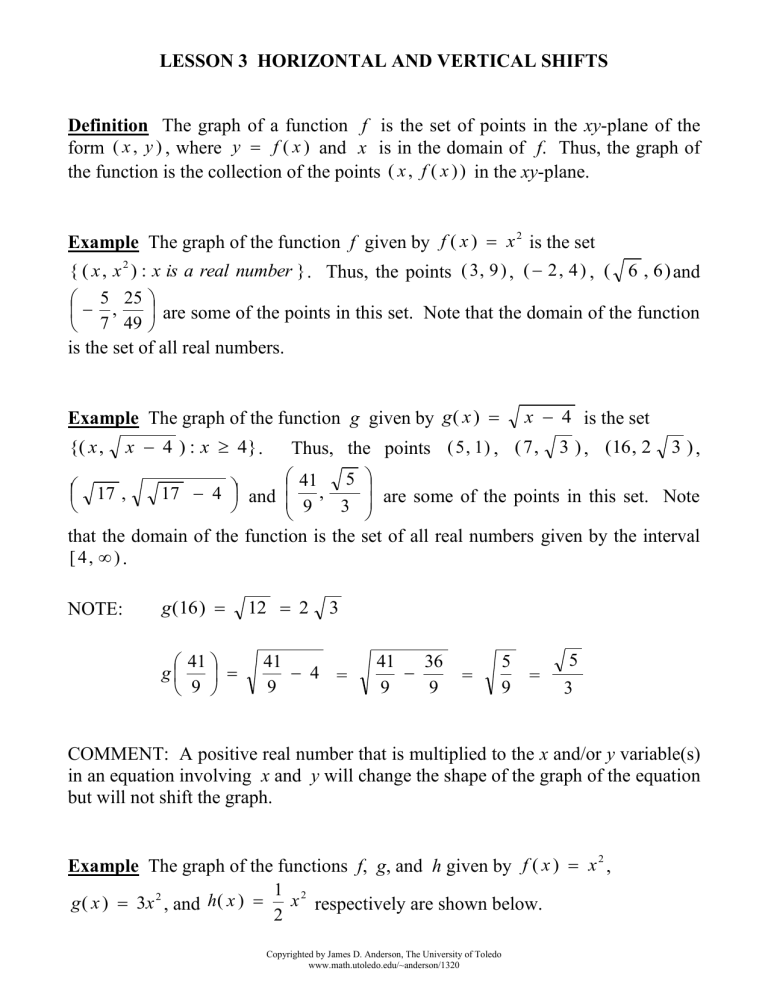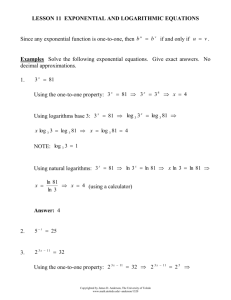Lesson 3 Horizontal and Vertical Shifts
advertisement

LESSON 3 HORIZONTAL AND VERTICAL SHIFTS
Definition The graph of a function f is the set of points in the xy-plane of the
form ( x , y ) , where y f ( x ) and x is in the domain of f. Thus, the graph of
the function is the collection of the points ( x , f ( x ) ) in the xy-plane.
Example The graph of the function f given by f ( x ) x 2 is the set
{ ( x , x 2 ) : x is a real number } . Thus, the points ( 3 , 9 ) , ( 2 , 4 ) , ( 6 , 6 ) and
5 25
,
are some of the points in this set. Note that the domain of the function
7 49
is the set of all real numbers.
Example The graph of the function g given by g ( x )
{( x ,
x 4 ) : x 4} .
x 4 is the set
Thus, the points ( 5 , 1 ) , ( 7 ,
3 ) , (16 , 2
3 ),
41
5
are some of the points in this set. Note
17 4 and ,
3
9
that the domain of the function is the set of all real numbers given by the interval
[ 4, ) .
17 ,
NOTE:
g (16 )
41
g
9
12 2
3
41
4 =
9
41
36
9
9
=
5
9
=
5
3
COMMENT: A positive real number that is multiplied to the x and/or y variable(s)
in an equation involving x and y will change the shape of the graph of the equation
but will not shift the graph.
Example The graph of the functions f, g, and h given by f ( x ) x 2 ,
1 2
x respectively are shown below.
g ( x ) 3x 2 , and h( x )
2
Copyrighted by James D. Anderson, The University of Toledo
www.math.utoledo.edu/~anderson/1320
NOTE: In order to graph the function f given by f ( x ) x 2 , we set f ( x ) y
and graph the equation y x 2 . In order to graph the function g given by
g ( x ) 3x 2 , we set g ( x ) y and graph the equation y 3x 2 . In order to
1 2
graph the function h given by h( x ) x , we set h( x ) y and graph the
2
1 2
equation y x .
2
The graph of f is red, the graph of g is green, and the graph of h is blue.
y
x
Definition The sketch of the graph of a function is a graph that is drawn from
memory usually plotting only one point. If the graph has a horizontal and/or
vertical asymptote(s), then we would draw them as dotted lines.
For example, we know that the graph of the function given by y x 2 is a parabola
whose vertex is at the origin and opens upward. The reason that we know this is
because at one time we drew the graph of this function by plotting points that we
would have obtained by the use of a table with a column labeled as x and a column
labeled as y. In order to create this table, we would have listed some of the
numbers in the domain of the function in the column labeled as x. We probably
used 3 , 2 , 1 , 0, 1, 2, and 3. Then in order to get the numbers in the column
labeled as y, we would have calculated the value of the function at these numbers
Copyrighted by James D. Anderson, The University of Toledo
www.math.utoledo.edu/~anderson/1320
obtaining 9, 4, 1, 0, 1, 4, and 9. Then we would have plotted the points ( 3 , 9 ) ,
( 2 , 4 ) , ( 1, 1 ) , ( 0 , 0 ) , ( 1, 1 ) , ( 2 , 4 ) , and ( 3 , 9 ) in the xy-plane.
COMMENT: Most of the time in mathematics, we are only interested in a sketch
of the graph of a function. In this case, we do not have to worry about the true
shape of the graph. However, we will have to worry about horizontal and/or
vertical shift(s) of the graph of function.
Example We talked about the graph of the function g given by g ( x )
above. The graph of this function is given below.
NOTE: To graph the function g, we set
y x 4.
y
x 4
g ( x ) y and graph the equation
x
The graph of y
x 4 is the graph of y
x shifted 4 units to the right.
NOTE: The domain of the function g is [ 4 , ) and the range of the function is
[ 0, ) .
Horizontal Shifts A positive real number that is added or subtracted to the x
variable in an equation involving x and y will produce a shift with respect to the xaxis in the xy-plane. Since you can only move to the left or to the right on the xaxis, the shift is to the left or to the right and is called a horizontal shift.
Let c be a positive real number. Then
1.
The graph of y f ( x c ) is the graph of y f ( x ) shifted c units to
the right.
Copyrighted by James D. Anderson, The University of Toledo
www.math.utoledo.edu/~anderson/1320
2.
The graph of y f ( x c ) is the graph of y f ( x ) shifted c units to
the left.
In order to identify the amount and direction of a horizontal shift, the coefficient of
the x variable must be one.
Let b and c be nonzero real numbers. Given y f ( b x c ) , we can factor
c
out the b, which is the coefficient of x, obtaining that y f b x . The
b
c
graph of y f b x , which is the graph of y f ( b x c ) , is the
b
c
c
0 or to the left if
graph of y f ( b x ) shifted
units to the right if
b
b
c
0 . The shape of the graph of y f ( b x ) is similar to the shape of the graph
b
of y f ( x ) .
Example Graph the function f given by f ( x )
3x 21 .
NOTE: To graph the function f, we set f ( x ) y and graph the equation
y 3x 21 . Since
3x 21 =
3( x 7 ) , then we graph the equation
y 3 ( x 7 ) . The graph of y
shifted 7 units to the left.
3( x 7 )
is the graph of y
y
x
Copyrighted by James D. Anderson, The University of Toledo
www.math.utoledo.edu/~anderson/1320
3x
NOTE: The domain of the function f is [ 7 , ) and the range of the function is
[ 0, ) .
Vertical Shifts A positive real number that is added or subtracted to the y variable
in an equation involving x and y will produce a shift with respect to the y-axis in
the xy-plane. Since you can only move upward or downward on the y-axis, the
shift is upward or downward and is called a vertical shift.
Let c be a positive real number. Then
1.
The graph of y c f ( x ) is the graph of y f ( x ) shifted c units
upward.
2.
The graph of y c f ( x ) is the graph of y f ( x ) shifted c units
downward.
In order to identify the amount and direction of a vertical shift, the coefficient of
the y variable must be one.
Example Graph the function h given by h( x )
NOTE: To graph the function h, we set
1 2
y
x 5.
2
y
1 2
x 5.
2
h ( x ) y and graph the equation
x
Copyrighted by James D. Anderson, The University of Toledo
www.math.utoledo.edu/~anderson/1320
1 2
1 2
x 5 is the same as the equation y 5
x . The
2
2
1 2
1 2
graph of y 5 x is the graph of y x shifted 5 units downward.
2
2
The equation y
NOTE: The domain of the function h is the set of all real numbers and the range
of the function is [ 5 , ) .
Examples Sketch the graph of the following equations. a is a positive real
number.
1.
y ax2
NOTE: The graph of this equation is a parabola whose vertex is at the origin
and opens upward.
y
x
2.
y ax2
NOTE: The graph of this equation is a parabola whose vertex is at the origin
and opens downward.
y
x
Copyrighted by James D. Anderson, The University of Toledo
www.math.utoledo.edu/~anderson/1320
3.
y ax3
y
x
4.
y ax3
y
x
5.
y
a x or y a
x
NOTE: The graph of each equation is the top half of the parabola whose
vertex is at the origin and opens to the right. The equation of the parabola
whose vertex is at the origin and opens to the right can be given by the
equation x a y 2 . Solving for y, we have that x a y 2
1
1
1
x
x . Note, that the graph of the
y2
x y
a
a
a
1
1
x
x is the bottom half of the parabola.
a
a
We will show a sketch of these equations in Example 6.
equation
y
Copyrighted by James D. Anderson, The University of Toledo
www.math.utoledo.edu/~anderson/1320
y
x
6.
y
a x or y a
x
NOTE: The graph of each equation is the bottom half of the parabola whose
vertex is at the origin and opens to the right.
y
x
7.
y
a x or y a
x
NOTE: The graph of each equation is the top half of the parabola whose
vertex is at the origin and opens to the left. The equation of the parabola
whose vertex is at the origin and opens to the left can be given by the
equation x a y 2 . Solving for y, we have that x a y 2
1
1
1
x . Note, that the graph of
y2 x y x
a
a
a
1
1
x
x is the bottom half of the
the equation
a
a
parabola. We will show a sketch of these equations in Example 8.
y
Copyrighted by James D. Anderson, The University of Toledo
www.math.utoledo.edu/~anderson/1320
y
x
8.
y
a x or y a
x
NOTE: The graph of each equation is the bottom half of the parabola whose
vertex is at the origin and opens to the left.
y
x
9.
y
3
a x or y a
3
x
y
x
10.
y 3 a x or y a
3
x
Copyrighted by James D. Anderson, The University of Toledo
www.math.utoledo.edu/~anderson/1320
y
x
11.
y a x
y
x
12.
y a x
y
x
Copyrighted by James D. Anderson, The University of Toledo
www.math.utoledo.edu/~anderson/1320
13.
y
a
a
or y n , where n is a positive odd integer
x
x
NOTE: The graph of each equation has the x-axis as a horizontal asymptote
and the y-axis as a vertical asymptote.
y
x
14.
y
a
a
or y n , where n is a positive odd integer
x
x
NOTE: The graph of each equation has the x-axis as a horizontal asymptote
and the y-axis as a vertical asymptote.
y
x
Copyrighted by James D. Anderson, The University of Toledo
www.math.utoledo.edu/~anderson/1320
15.
y
a
a
or y n , where n is a positive even integer
2
x
x
NOTE: The graph of each equation has the x-axis as a horizontal asymptote
and the y-axis as a vertical asymptote.
y
x
16.
y
a
a
y
or
, where n is a positive even integer
x2
xn
NOTE: The graph of each equation has the x-axis as a horizontal asymptote
and the y-axis as a vertical asymptote.
y
x
Copyrighted by James D. Anderson, The University of Toledo
www.math.utoledo.edu/~anderson/1320
Examples Sketch the graph of the following functions. State the domain of the
function and use the sketch to state the range of the function.
1.
f ( x ) 2( x 4) 2 3
The domain of f is the set of all real numbers.
To graph the function f, we set f ( x ) y and graph the equation
y 2( x 4) 2 3 .
y 2( x 4) 2 3 y 3 2( x 4) 2
The graph of y 3 2 ( x 4 ) 2 is the graph of y 2 x 2 shifted 4 units
to the right and 3 units downward.
y
x
The range of f is [ 3 , ) .
NOTE: The horizontal shift of 4 units to the right is determined from the
expression x 4 in the equation y 3 2 ( x 4 ) 2 and the vertical
shift of 3 units downward is determined from the expression y 3 in the
equation.
NOTE: To find the y-coordinate of the y-intercept of the graph of the
equation y 2 ( x 4 ) 2 3 , we would set x 0 obtaining that
Copyrighted by James D. Anderson, The University of Toledo
www.math.utoledo.edu/~anderson/1320
y 2 ( 4 ) 2 3 . Thus, y 32 3 29 . Thus, the y-intercept is the
point ( 0 , 29 ) .
To find the x-coordinate of the x-intercepts of the graph of the equation
y 3 2 ( x 4 ) 2 , we would set y 0 obtaining that
3 2 ( x 4 ) 2 . Solving for x, we have that 3 2 ( x 4 ) 2
6
3
x 4
2
2
8 6
=
. Thus, the x-intercepts are the
2
8 6
, 0 .
2
3
( x 4) 2 x 4
2
6
8
2
2
2
8 6
and
,
0
points
2
x 4
2.
6
=
g ( x ) 5 ( x 12 ) 2
The domain of g is the set of all real numbers.
To graph the function g, we set g ( x ) y and graph the equation
y 5 ( x 12 ) 2 .
The graph of y 5 ( x 12 ) 2 is the graph of
units to the left. There is no vertical shift.
y 5 x 2 shifted 12
y
x
Copyrighted by James D. Anderson, The University of Toledo
www.math.utoledo.edu/~anderson/1320
The range of g is ( , 0 ] .
NOTE: The horizontal shift of 12 units to the left is determined from the
expression x 12 in the equation y 5 ( x 12 ) 2 .
NOTE: To find the y-coordinate of the y-intercept of the graph of the
equation y 5 ( x 12 ) 2 , we would set x 0 obtaining that
y 5 ( 12 ) 2 . Thus, y 5 ( 144 ) 720 . Thus, the y-intercept is the
point ( 0 , 720 ) .
To find the x-coordinate of the x-intercept of the graph of the equation
y 5 ( x 12 ) 2 , we would set y 0 obtaining that
0 5 ( x 12 ) 2 . Solving for x, we have that 0 5 ( x 12 ) 2
0 ( x 12 ) 2 x 12 0 x 12 . Thus, the x-intercept is
the point ( 12 , 0 ) . Of course, we could have obtain this from the sketch of
the graph of the equation y 5 ( x 12 ) 2 .
3.
h( x )
3
( x 2) 3 6
4
The domain of h is the set of all real numbers.
To graph the function h, we set h( x ) y and graph the equation
3
y ( x 2) 3 6.
4
y
3
3
( x 2) 3 6 y 6 ( x 2) 3
4
4
3
( x 2 ) 3 is the graph of
4
units to the left and 6 units upward.
The graph of
y 6
Copyrighted by James D. Anderson, The University of Toledo
www.math.utoledo.edu/~anderson/1320
y
3 3
x shifted 2
4
y
x
The range of h is the set of all real numbers.
NOTE: The horizontal shift of 2 units to the left is determined from the
3
3
expression x 2 in the equation y 6 ( x 2 ) and the vertical
4
shift of 6 units upward is determined from the expression y 6 in the
equation.
NOTE:
To find the y-coordinate of the y-intercept of the graph of the
3
3
equation y ( x 2 ) 6 , we would set x 0 obtaining that
4
3
3
y ( 2 ) 3 6 . Thus, y ( 8 ) 6 6 6 12 . Thus, the y4
4
intercept is the point ( 0 , 12 ) .
To find the x-coordinate of the x-intercept of the graph of the equation
3
y 6 ( x 2 ) 3 , we would set y 0 obtaining that
4
3
3
6 ( x 2 ) 3 . Solving for x, we have that 6 ( x 2 ) 3
4
4
24 3 ( x 2 ) 3 8 ( x 2 ) 3 x 2 3 8
x 2 2 x 4 . Thus, the x-intercept is the point ( 4 , 0 ) .
Copyrighted by James D. Anderson, The University of Toledo
www.math.utoledo.edu/~anderson/1320
4.
f ( t ) ( t 8) 3 3
The domain of f is the set of all real numbers.
To graph the function f, we set f ( t ) y and graph the equation
y ( t 8) 3 3 .
y ( t 8) 3 3 y 3 ( t 8) 3
The graph of y 3 ( t 8 ) 3 is the graph of y t 3 shifted 8 units
to the right and 3 units upward.
y
t
The range of f is the set of all real numbers.
NOTE: The horizontal shift of 8 units to the right is determined from the
expression t 8 in the equation y 3 ( t 8 ) 3 and the vertical shift
of 3 units upward is determined from the expression y 3 in the equation.
NOTE: To find the y-coordinate of the y-intercept of the graph of the
equation y ( t 8 ) 3 3 , we would set t 0 obtaining that
y ( 8 ) 3 3 . Thus, y ( 512 ) 3 512 3 515 . Thus,
the y-intercept is the point ( 0 , 515 ) .
Copyrighted by James D. Anderson, The University of Toledo
www.math.utoledo.edu/~anderson/1320
To find the t-coordinate of the t-intercept of the graph of the equation
y 3 ( t 8 ) 3 , we would set y 0 obtaining that
3 ( t 8 ) 3 . Solving for t, we have that 3 ( t 8 ) 3
3 ( t 8) 3 t 8
the point ( 8
5.
g( x ) 2
3
3
3 t 8
3
3 . Thus, the t-intercept is
3 , 0) .
x 4
The domain of g is [ 0 , ) .
To graph the function g, we set g ( x ) y and graph the equation
y 2 x 4.
y 2
x 4 y 4 2
x
The graph of y 4 2 x is the graph of y 2
downward. There is no horizontal shift.
x shifted 4 units
y
x
The range of g is [ 4 , ) .
NOTE: The vertical shift of 4 units downward is determined from the
expression y 4 in the equation y 4 2 x .
NOTE: To find the y-coordinate of the y-intercept of the graph of the
equation y 2 x 4 , we would set x 0 obtaining that
y 2 0 4 . Thus, y 2 ( 0 ) 4 4 . Thus, the y-intercept is the
point ( 0 , 4 ) . Of course, we could have obtain this from the sketch of the
Copyrighted by James D. Anderson, The University of Toledo
www.math.utoledo.edu/~anderson/1320
graph of the equation y 2
x 4.
To find the x-coordinate of the x-intercept of the graph of the equation
y 4 2 x , we would set y 0 obtaining that
4 2 x . Solving for x, we have that 4 2 x 2
x 4 . Thus, the x-intercept is the point ( 4 , 0 ) .
6.
h( t )
x
5 t 30 11
To graph the function h, we set h( t ) y and graph the equation
y 5 t 30 11 .
NOTE: The coefficient of the t variable in the expression 5 t 30 is not
one. We will need to factor out the coefficient of 5 in order to identify the
amount and the direction of the horizontal shift.
y
5t 30 11 y 11
5( t 6 )
For the domain of h, we need that 5 ( t 6 ) 0 . Thus, t 6 0
t 6 . Thus, the domain of h is ( , 6 ] .
The graph of y 11 5 ( t 6 ) is the graph of y
6 units to the left and 11 units downward.
5 t shifted
y
t
The range of h is [ 11, ) .
Copyrighted by James D. Anderson, The University of Toledo
www.math.utoledo.edu/~anderson/1320
NOTE: The horizontal shift of 6 units to the left is determined from the
expression t 6 in the equation y 11 5 ( t 6 ) and the vertical
shift of 11 units downward is determined from the expression y 11 in the
equation.
NOTE: To find the y-coordinate of the y-intercept of the graph of the
equation y 5 t 30 11 , we would set t 0 obtaining that
y
30 11 . Thus, y 11 i
30 , a complex number. Thus,
the equation y 5 t 30 11 does not have a y-intercept. Of
course, we could have obtain this from the sketch of the graph of the equation
y 5 t 30 11 .
To find the t-coordinate of the t-intercept of the graph of the equation
y 11 5 ( t 6 ) , we would set y 0 obtaining that
11
5 ( t 6 ) . Solving for t, we have that 11
121 5 ( t 6 ) 121 5 t 30
5( t 6 )
151
5t 1 5 1 t
.
5
151
, 0 .
Thus, the t-intercept is the point
5
7.
y
11
6
3x 7 2
NOTE: Functional notation is not being used here. However, we still have a
function. The variable y is a function of the variable x. If we wanted, we
11
3x 7 2 .
could introduce functional notation by writing y ( x )
6
The name of the function would become y when you do this.
NOTE: The coefficient of the x variable in the expression 3x 7 is not
one. We will need to factor out the coefficient of 3 in order to identify the
amount of the horizontal shift.
y
11
6
3x 7 2 y 2
11
6
Copyrighted by James D. Anderson, The University of Toledo
www.math.utoledo.edu/~anderson/1320
7
3 x
3
7
For the domain of the function, we need that 3 x 0 . Thus,
3
7
7
7
x
0 x . Thus, the domain of the function is , .
3
3
3
The graph of y 2
shifted
11
6
7
11
3 x is the graph of y
3
6
3x
7
units to the right and 2 units upward.
3
y
7
3
x
The range of the function is ( , 2 ] .
NOTE: The horizontal shift of
7
units to the right is determined from the
3
11
7
7
3 x
in the equation y 2
6
3
3
vertical shift of 2 units upward is determined from the expression
the equation.
expression
x
NOTE:
and the
y 2 in
To find the y-coordinate of the y-intercept of the graph of the
11
3x 7 2 , we would set x 0 obtaining that
equation y
6
11
y
7 2 . Since 7 i 7 , then y is a complex number.
6
11
3x 7 2 does not have a y-intercept.
Thus, the equation y
6
Of course, we could have obtain this from the sketch of the graph of the
11
3x 7 2 .
equation y
6
Copyrighted by James D. Anderson, The University of Toledo
www.math.utoledo.edu/~anderson/1320
To find the x-coordinate of the x-intercept of the graph of the equation
11
y 2
3x 7 , we would set y 0 obtaining that
6
11
11
2
3x 7 . Solving for x, we have that 2
3x 7
6
6
12
144
3x 7 3x 7
363x 847 144
11
121
363x 991 x
8.
f ( x)
3
991
991
, 0.
. Thus, the x-intercept is the point
363
363
5 x 4
The domain of f is the set of all real numbers.
To graph the function f, we set f ( x ) y and graph the equation
y 3 5 x 4.
NOTE: The coefficient of the x variable in the expression 5 x is not one.
We will need to factor out the coefficient of 1 in order to identify the
amount and the direction of the horizontal shift.
y
3
5 x 4 y 4
3
( x 5) y 4 3 x 5
The graph of y 4 3 x 5 is the graph of y 3 x shifted 5
units to the right and 4 units downward.
y
x
The range of f is the set of all real numbers.
Copyrighted by James D. Anderson, The University of Toledo
www.math.utoledo.edu/~anderson/1320
NOTE: The horizontal shift of 5 units to the right is determined from the
expression x 5 in the equation y 4 3 x 5 and the vertical
shift of 4 units downward is determined from the expression y 4 in the
equation.
NOTE: To find the y-coordinate of the y-intercept of the graph of the
equation y 3 5 x 4 , we would set x 0 obtaining that
y
3
5 4 . Thus, the y-intercept is the point ( 0 , 3 5 4 ) .
To find the x-coordinate of the x-intercept of the graph of the equation
y 4 3 5 x , we would set y 0 obtaining that
4 3 5 x . Solving for x, we have that 4 3 5 x
64 5 x x 59 . Thus, the x-intercept is the point ( 59 , 0 ) .
9.
g ( x ) 6 x 18
The domain of g is the set of all real numbers.
To graph the function g, we set g ( x ) y and graph the equation
y 6 x 18 .
NOTE: The coefficient of the x variable in the expression 6 x 18 is not
one. We will need to factor out the coefficient of 6 in order to identify the
amount of the horizontal shift.
y 6x 18 y 6 ( x 3 ) y 6 x 3
The graph of y 6 x 3 is the graph of y 6 x shifted 3 units to
the right. There is no vertical shift.
Copyrighted by James D. Anderson, The University of Toledo
www.math.utoledo.edu/~anderson/1320
y
x
The range of g is [ 0 , ) .
NOTE: The horizontal shift of 3 units to the right is determined from the
expression x 3 in the equation y 6 x 3 .
NOTE: To find the y-coordinate of the y-intercept of the graph of the
equation y 6 x 3 , we would set x 0 obtaining that
y 6 3 . Thus,
( 0 , 18 ) .
y 6 3 18 Thus, the y-intercept is the point
To find the x-coordinate of the x-intercept of the graph of the equation
y 6 x 3 , we would set
y 0 obtaining that 0 6 x 3 .
Solving for x, we have that 0 6 x 3 0 x 3
0 x 3 x 3 . Thus, the x-intercept is the point ( 3 , 0 ) . Of
course, we could have obtain this from the sketch of the graph of the equation
y 6 x 3 .
10.
h( x ) 4 x 9 7
The domain of h is the set of all real numbers.
To graph the function h, we set h( x ) y and graph the equation
y 4x 9 7 .
Copyrighted by James D. Anderson, The University of Toledo
www.math.utoledo.edu/~anderson/1320
NOTE: The coefficient of the x variable in the expression 4 x 9 is not
one. We will need to factor out the coefficient of 4 in order to identify the
amount of the horizontal shift.
9
9
y 7 4x 9 y 7 4 x y 7 4 x
4
4
9
4
units to the left and 7 units upward.
The graph of y 7 4 x
is the graph of y 4 x shifted
9
4
y
9
4
x
The range of h is ( , 7 ] .
9
units to the left is determined from the
4
9
9
expression x
in the equation y 7 4 x
and the vertical
4
4
shift of 7 units upward is determined from the expression y 7 in the
equation.
NOTE: The horizontal shift of
NOTE: To find the y-coordinate of the y-intercept of the graph of the
equation y 4 x 9 7 , we would set x 0 obtaining that
Copyrighted by James D. Anderson, The University of Toledo
www.math.utoledo.edu/~anderson/1320
y 9 7 . Thus, y 9 7 9 7 2
intercept is the point ( 0 , 2 ) .
Thus, the y-
To find the x-coordinate of the x-intercepts of the graph of the equation
y 7 4 x 9 , we would set y 0 obtaining that
7 4 x 9 . Solving for x, we have that 7 4 x 9
9 7
7 4 x 9 4x 9 7 4x 9 7 x
.
4
9 7
2
1
9 7
16
x
4 Thus, the xor x
4
4
2
4
4
1
intercepts are the points ( 4 , 0 ) and , 0 .
11.
f ( x)
2
4
8
3x 2
The domain of f is the set of all real numbers x such that x 0 .
To graph the function f, we set f ( x ) y and graph the equation
4
y
8.
3x 2
y
4
4
8
y
8
3x 2
3x 2
4
is the graph of
3x 2
upward. There is no horizontal shift.
The graph of
y 8
y
4
shifted 8 units
3x 2
4
has the x-axis as a horizontal
3x 2
asymptote. The vertical shift of 8 units upward will shift this horizontal
4
asymptote 8 units upward. Thus, the graph of y 8
will have the
3x 2
line y 8 as a horizontal asymptote. We also know that the graph of
NOTE: We know that the graph of y
Copyrighted by James D. Anderson, The University of Toledo
www.math.utoledo.edu/~anderson/1320
4
has the y-axis as a vertical asymptote. The vertical shift will not
3x 2
4
affect this vertical line. Thus, the graph of y 8
will have the y3x 2
axis as a vertical asymptote.
y
y
x
The range of f is ( 8 , ) .
NOTE:
The vertical shift of 8 units upward is determined from the
4
expression y 8 in the equation y 8
.
3x 2
4
, we can
3x 2
see that the graph does not have any x-intercepts nor a y-intercept.
NOTE: From the sketch of the graph of the equation y 8
12.
g( x )
14
6
2x 5
The domain of g is the set of all real numbers x such that x
Copyrighted by James D. Anderson, The University of Toledo
www.math.utoledo.edu/~anderson/1320
5
.
2
To graph the function g, we set g ( x ) y and graph the equation
14
y
6.
2x 5
NOTE: The coefficient of the x variable in the expression 2 x 5 is not
one. We will need to factor out the coefficient of 2 in order to identify the
amount of the horizontal shift.
y
14
7
14
y 6
6 y 6
5
5
2x 5
x
2 x
2
2
7
7
5
y
is
the
graph
of
shifted
units
5
x
2
x
2
to left and 6 units downward.
The graph of y 6
7
has the x-axis as a horizontal
x
asymptote. The vertical shift of 6 units downward will shift this horizontal
asymptote 6 units downward. The horizontal shift will not affect this
7
y
6
horizontal line. Thus, the graph of
5 will have the line
x
2
y 6 as a horizontal asymptote. We also know that the graph of
7
5
y
has the y-axis as a vertical asymptote. The horizontal shift of
x
2
5
units to the left will shift this vertical asymptote
units to the left. The
2
vertical shift will not affect this vertical line. Thus, the graph of
7
5
y 6
x
will
have
the
line
as a vertical asymptote.
5
2
x
2
NOTE: We know that the graph of y
Copyrighted by James D. Anderson, The University of Toledo
www.math.utoledo.edu/~anderson/1320
y
5
2
x
The range of g is ( , 6 ) ( 6 , ) .
5
units to the left is determined from the
2
7
5
expression x
in the equation y 6
5 and the vertical shift
2
x
2
of 6 units downward is determined from the expression y 6 in the
equation.
NOTE: The horizontal shift of
NOTE:
To find the y-coordinate of the y-intercept of the graph of the
14
6 , we would set x 0 obtaining that
equation y
2x 5
14
14
14
30
44
y
6 . Thus, y
6
Thus, the y5
5
5
5
5
44
intercept is the point 0 , .
5
To find the x-coordinate of the x-intercept of the graph of the equation
14
y 6
, we would set y 0 obtaining that
2x 5
Copyrighted by James D. Anderson, The University of Toledo
www.math.utoledo.edu/~anderson/1320
6
14
14
. Solving for x, we have that 6
2x 5
2x 5
6 ( 2 x 5 ) 14 3 ( 2 x 5 ) 7 6 x 15 7
6 x 22 x
11
11
. Thus, the x-intercept is the points , 0 .
3
3
Copyrighted by James D. Anderson, The University of Toledo
www.math.utoledo.edu/~anderson/1320









